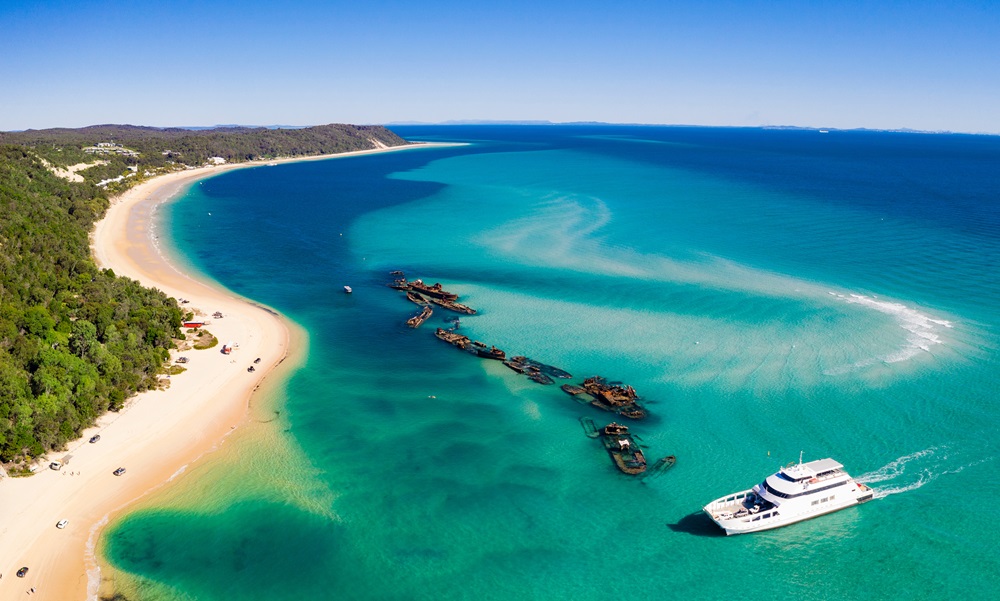 Internationally recognised for its biodiverse ecosystems, the iconic Moreton Bay is the largest and most unique estuarine bay in Australia. Here, tropical and temperate flora and fauna coexist, surrounded – and increasingly encroached on – by millions of people who live, work and play in the area. It is an urban seascape located near one of Australia’s fastest growing metropolitan areas, with a 50 per cent population increase across Brisbane and the Gold Coast expected between now and 2041 – and it is environmentally vulnerable.
Internationally recognised for its biodiverse ecosystems, the iconic Moreton Bay is the largest and most unique estuarine bay in Australia. Here, tropical and temperate flora and fauna coexist, surrounded – and increasingly encroached on – by millions of people who live, work and play in the area. It is an urban seascape located near one of Australia’s fastest growing metropolitan areas, with a 50 per cent population increase across Brisbane and the Gold Coast expected between now and 2041 – and it is environmentally vulnerable.
At the heart of Moreton Bay are its Traditional Owners and Indigenous cultural heritage. More than 2,000 Quandamooka and Kabi Kabi people continue to practice cultural, spiritual, educational, and environmental stewardship of the land and waters with which they have a more than 25,000-year relationship. The Quandamooka Yoolooburrabee Aboriginal Corporation (QYAC) is seeking to have Moreton Bay designated a UNESCO World Heritage site.
Approximately 1,000 native animal species, many threatened, live in Moreton Bay or rely on its diverse, interconnected habitats during migration. These include well over 360 bird species – more than 40 per cent of all bird species in Australia - 6 of the world’s seven sea turtle species, many species of shark, including the highly endangered grey nurse, stingrays and manta rays, bottlenose, and humpback dolphins, as many as 800 vulnerable dugongs, humpback and other whales and a vast array of tropical and temperate fish.
The southernmost populations of many tropical species, like dugongs and humpback dolphins, are found in Moreton Bay along with the northernmost populations of many temperate species. The overlap of ocean climatic zones is a major contributing factor to the area’s unique biodiversity. Habitats range from sandy beaches, mangroves and salt marshes to seagrass meadows, rocky shores, intertidal mudflats, and beautiful coral reefs.
What makes Moreton Bay special is also what puts it at risk. As a relatively shallow body of water, it acts like a semi-enclosed, sheltered lagoon separated from the ocean by sand islands. It is accessible and picturesque – and it is heavily impacted by human development. The bayside suburbs of Greater Brisbane impact its western shores, while some 2.5 million people – approximately 10 per cent of the Australian population – live in the central and northern bay surrounds. It accumulates sediment, nutrients, pollutants and litter that flow in from fourteen major river catchments. Land erosion is a significant issue.
Without question, the area is damaged ecologically and this damage will be amplified as environmental pressures intensify. Robust conservation strategies and practice, including substantial intervention, are imperative to the long-term health and sustainability of the bay and its ecosystems. Critically, the social context in which this takes place cannot be ignored. Moreton Bay’s historical, socio-political and economic landscape is complex and challenging to navigate – a jigsaw puzzle evolved over many years, with many pieces and players. Change will require committed effort and collaboration across a diversity of interests, stakeholders, and constituencies.
The time has never been better for the Healthy Moreton Bay Initiative being launched at UQ, in collaboration with partners that include The Goodman Foundation. Brisbane and Australia will be showcased to the world through the 2032 Games. The region will change significantly as it prepares to host an international event of almost unparalleled profile with a strong sustainability agenda. We have a window of opportunity to ensure one of those changes is achieving a Healthy Moreton Bay.
“Moreton Bay is an incredible place,” UQ’s Professor Michael Noad said.
“It is a wonderful mosaic of interconnected habitats that allow it to support one of the highest levels of biodiversity of anywhere along Australia’s coastline.
“The health of Moreton Bay, however, is declining just as we need it to be as healthy as possible to increase its resilience to climate change.”
A healthy and sustainably managed Moreton Bay by 2032 relies on a deep understanding of its ecological pressures and identifying viable, actionable strategies for relieving them to preserve its exceptional biodiversity. Interdisciplinary field research, in collaboration with NGOs, along with data synthesis, modelling and solutions testing will all play a significant role, led by a Healthy Moreton Bay research chair to be philanthropically funded.
With a history spanning over 50 years in the area, UQ’s relationships at Moreton Bay extend well beyond research and the University is well-positioned to play a transformative role in the restoration and ongoing conservation of the bay. Already, considerable investment in Moreton Bay research has been made, in partnership with other universities and organisations. Existing world-class interdisciplinary expertise and resources, much of it tied to UQ’s Moreton Bay Research Station, mean the initiative begins from a position of strength.
2032 Games aside, the increasing profile of climate change and its social and economic impact has sparked a growing appetite for environmental protection, intervention and restoration. The public, politicians and corporations are paying attention to the rising number of severe weather events, coral bleaching and the jeopardy that valued coastal communities the world over find themselves in due do ecological decline.
Biodiversity, sustainability and conservation are more and more the topics of the day – wicked challenges that UQ is already fully engaged with, where the University has solid government and industry connections, and where collaborations extend internationally. Sadly, the threats facing Moreton Bay from urbanisation and environmental pressures are not isolated. They reflect problems facing coastal ecosystems around the world. The research and knowledge gained from UQ’s Healthy Moreton Bay Initiative will have worldwide relevance and impact.
The goal of this initiative is to develop and embed sustainable ecological management process and practice to eliminate the dangers and losses that Moreton Bay now grapples with. This includes addressing the problem of sediment runoff that smothers coral reefs and seagrass beds already vulnerable from warming temperature, killing the many and varied species that rely on them for life.
It is a ‘whole is greater than the sum of the parts’ approach to generating new understanding and applications for effective planning, conservation and community engagement. UQ’s Centre for Marine Science and Centre for Biodiversity and Conservation Science will work collaboratively with Traditional Owners and community partners – governments, NGOs, businesses – to support sound decision making and real change.
The Healthy Moreton Bay Initiative at UQ is about local as well as global impact. Through it, best practice in coastal ecosystem conservation will evolve in new and innovative ways. A thriving Moreton Bay will be the result, ensuring this extraordinary place is protected, preserved, enjoyed, and respected for generations to come.
To support the Healthy Moreton Bay Initiative, please contact Brenda Tournier: sci.advancement@uq.edu.au.



